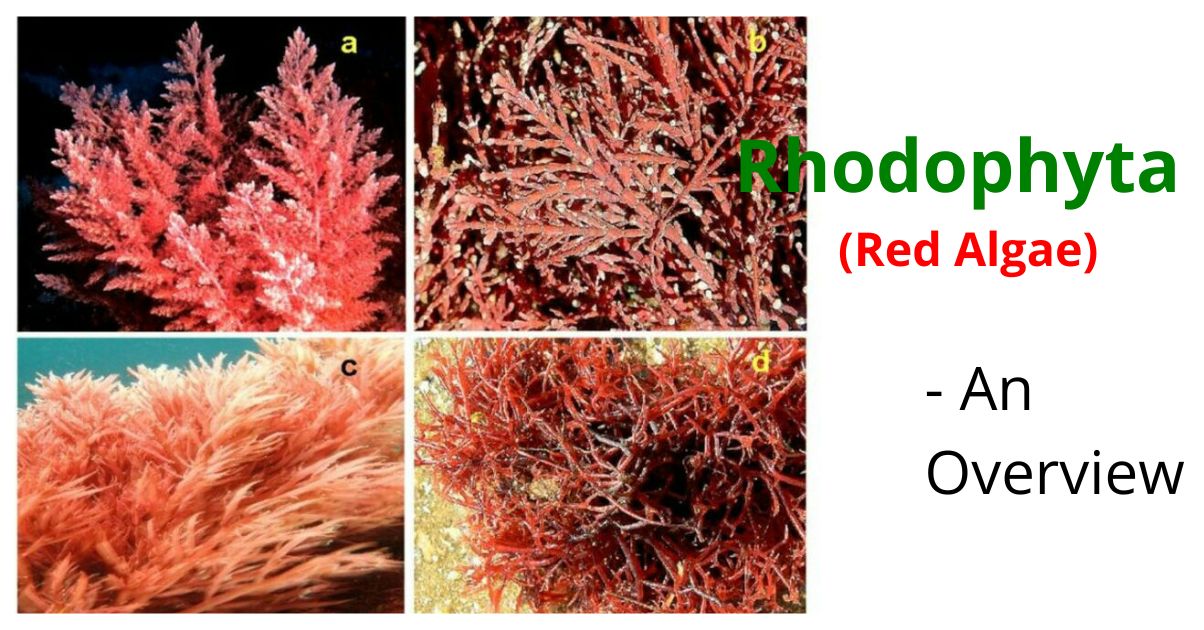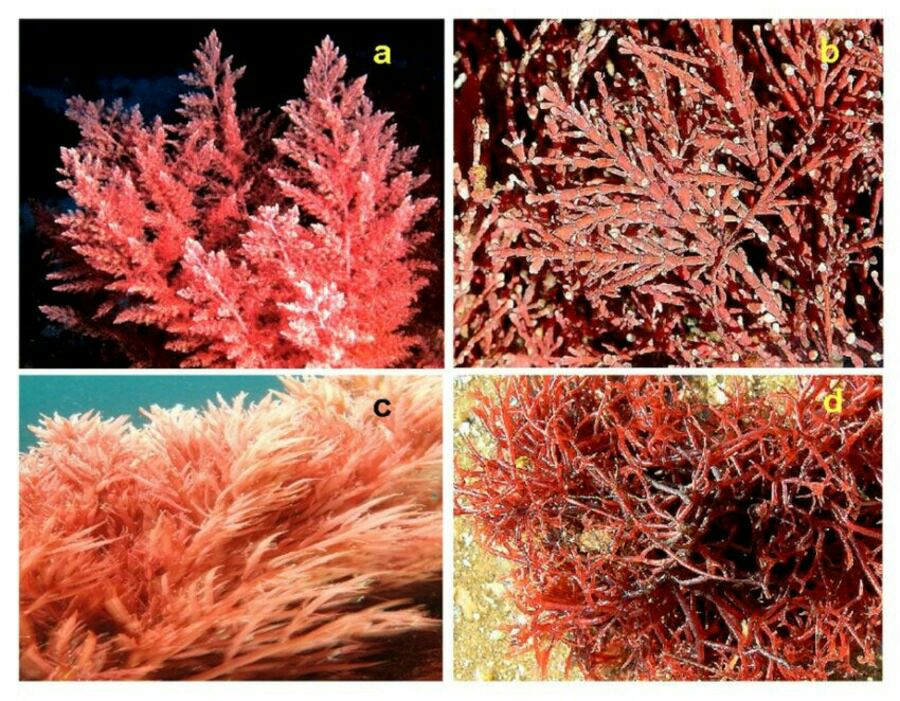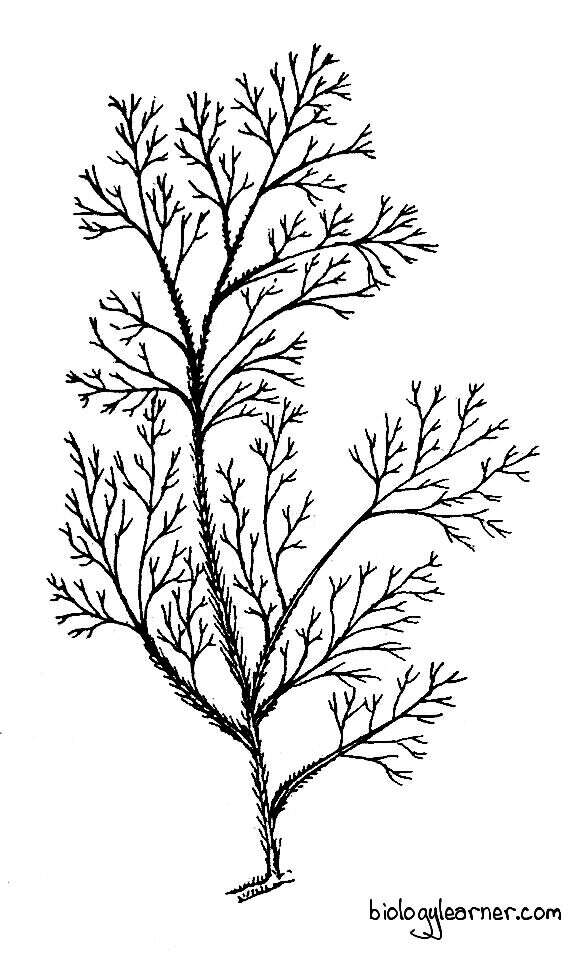Algae found in the group Rhodophyta (class Rhodophyceae) are red in colour. So these are also known as red algae.
The algae show red colour due to the presence of the red pigments r-phycocyanin and r-phycoerythrin.
Characteristics of Rhodophyta
- Most of the red algae are marine, and a few species occur in freshwater (only 2%). They may grow either as saprophytes, epiphytes, or parasites.
- The plant body, or thallus, is usually multicellular, but Porphyridium shows a unicellular plant body.
- The multicellular thallus may be filamentous (Goniotrichum), pseudoparenchymatous (Helminthocladia), parenchymatous (Porphyra), feathery (Polysiphonia), or ribbon-like (Chondrus).
- Flagellated motile cells are absent in all the members of Rhodophyta.
- The cell wall is bi-layered and consists of an outer pectic layer and an inner cellulosic layer.
- The photosynthetic pigments are chlorophyll-a, α and β carotenes, zeaxanthin, flavoxanthin, and violaxanthin, which are present in chromatophores.
- The chlorophyll-a is masked by the red pigment r-phycoerythrin, which gives the characteristic red colour to this group. The blue pigment phycocyanin also occurs in the chloroplasts of Rhodophyta. These two pigments are phycobiliproteins and are found in hemispherical bodies on the surfaces of the thylakoids.
- The most important reserve food is a polysaccharide, floridean starch, which accumulates in the cytoplasm, next to the chloroplast envelope.
- The adjacent cells are connected to each other by pit connections (cytoplasmic connections).
- Sexual reproduction is of the highly specialised and advanced oogamous type.
- Male gametes are non-flagellated spermatia produced in the spermatangium (male sex organ). The female sex organ is known as the carpogonium.
- Distinct post-fertilisation changes can be seen in this group.
- Asexual reproduction occurs through many non-flagellate asexual spores, such as monospore, bispore, tetraspore, neutral spore, polyspore, paraspore, carpospore, etc. Carpospore is produced in the carposporangium.
- Most of the members of Rhodophyta exhibit a biphasic or triphasic life cycle.

Distribution of Rhodophyta
The division Rhodophyta is often referred to as sea mosses or sea weeds. There are about 5000–5500 species of red algae, which are distributed among 400–500 genera.
Most of the members of red algae are marine, and the rest occur in freshwater.
The freshwater red algae are found in shallow, stagnant water (e.g., Compsopogon) as well as free-flowing water (e.g., Batrachospermum, Lemanea).
The marine species usually grow attached to rocks. They can also grow on other solid substrata. Some members exhibit a high degree of epiphytism and parasitism.
Epiphytism can be seen in members like Ceratocolax and Rhodochorton. They grow on other members of red algae. Ceramium condicola is parasitic on Codium fragile, while Polysiphonia fastigiata is often found to be growing on Ascophyllum nodosum as a semiparasite.
Porphyridium, a unicellular red alga, is terrestrial and grows on damp soil.

Thallus Organization of Rhodophyta
Thallus may be unicellular or multicellular. Only a unicellular thallus is found in Porphyridium.
On the basis of their structure, Rhodophyta thallus are of two types:
- Filamentous: It is a uniaxial thallus in which cells are attached in the form of fibers. The side branches come out from the main axis (e.g., Batrachospermum).
- Corticated: In this type, the thallus is multiaxial. Here the thallus consists of one central axis along with many filaments, forming a structure known as pseudoparenchymatous (e.g., Ceramium, Polysiphonia).

Cell Structure of Rhodophyta
The cell has the following main components:
- Cell Wall: Each cell is surrounded by a thick cell wall. It is differentiated into two layers. The outer layer is made up of pectin, and the inner layer consists of cellulose. In some members, calcium, magnesium, and iron are also present in the cell wall.
- Nucleus: In each cell, usually one or two nuclei are found.
- Chloroplasts and Storage Product: The cells have either one stellate chromatophore (sub-class Bangioideae) or many discoid parietal chromatophores (sub-class Florideae). The chromatophores contain pigments like chlorophyll-a, β-carotenes, xanthophylls, phycocyanin-r, phycoerythrin-r, etc. Floridean starch is present as the reserve food material in the cytoplasm.
- Cell Organelles: Various cell organelles such as dictyosomes, mitochondria, and endoplasmic reticulum are also present.
- Pit Connections: In all members of this group, pit connections are seen between adjacent cells. The primary pit connection is formed during cell division. At the time of cell plate formation, some part of the cell is present where the cell plate is not formed, while secondary pit connections are found only in mature cells.
Reproduction in Rhodophyta
Members of Rhodophyta reproduce by all three methods: vegetative, asexual, and sexual.
Vegetative Reproduction
Vegetative reproduction is very rare in red algae. It takes place only in unicellular form by simple cell division.
Some organisms are able to regenerate whole plants from several holdfasts.
Asexual Reproduction
Asexual reproduction takes place through a variety of non-motile spores. These are monospores, bispores, tetraspores, carpospores, paraspores, and neutral spores.
Sexual Reproduction
Sexual reproduction is of the advanced oogamous type.
The male sex organ is known as the spermatangium. It is a very simple, one-celled structure that contains a single uninucleate, one-celled male gamete spermatium.
The female sex organ is called the carpogonium. It is also a single-celled structure. Each carpogonium has a long neck-like structure known as the trichogyne and a bulbous base called the carpogonial base. Inside the carpogonial base, the female nucleus or egg is present.
Male and female gametes fuse together to form a diploid zygote, or oospore. Later, the zygote produces carpospores. In Polysiphonia, the carpospores are diploid, while haploid carpospores are found in Batrachospermum.
The red algae, which have a very elaborate post-fertilisation stage, develop a prolonged diploid phase.
The sporophyte that remains attached to the female gametophyte is called the carposporophyte or cystocarp. It produces diploid carpospores.
On germination, the carposopre gives rise to a diploid independent plant known as a tetrasporophyte.
Alternation of Generation in Rhodophyta
Most Rhodophyta species show a biphasic or triphasic life cycle.
In a biphasic life cycle, the haploid gametophytic generation alternates with either the haploid carposporophytic or the diploid carposporophytic generation.
The triphasic life cycle indicates three generations, one of which is a haploid generation (gametophyte), and the other two are diploid generations (carposporophyte and tetrasporophyte).
Classification of Rhodophyta
The division Rhodophyta contains the class Rhodophyceae. Fritsch (1935, 45) classified the class Rhodophyceae into two sub-classes and seven orders on the basis of morphology and reproductive structures.
The classification of red algae is outlined as follows:
- Sub-class 1. Bangioideae
- Order 1. Bangiales (e.g., Porphyra)
- Sub-class 2. Florideae
- Order 1. Nemalionales (e.g., Batrachospermum)
- Order 2. Gelidiales (e.g., Gelidium)
- Order 3. Cryptonemiales (e.g., Corallina)
- Order 4. Gigartinales (e.g., Iridea)
- Order 5. Rhodymeniales (e.g., Champea)
- Order 6. Ceramiales (e.g., Polysiphonia)
